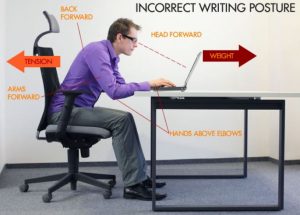This article lays out ergonomic solutions to the repetitive stress problems that writers usually face in their everyday work. Writing may seem static, however, it is a physically demanding task. Some of the most renowned writers in the world have in the course of time spend decades sitting on a chair tapping on a keyboard, staring at a screen. Such experiences often result in neck pain, elbow pain, shoulder pain, back pain, wrist pain, and forearm pain – sometimes to a point where you question whether you will be able to continue editing, designing, or any other writing-related activity from which you derive enjoyment and income.
Here are some of the basic principles that apply when exploring the world of ergonomics for writers:
Posture and Spinal Alignment
The spine is a structure composed of stacks of vertebrae that have “padding” rings between them. The muscles that connect the vertebrae allow us to flex our backs from side-to-side, forward, and backward. Because of the spine’s natural curves, — outward at the upper back and inward at the lower back, it will never align itself perfectly like a dish stack. However, if you lean forward, your upper body weight as well as that of your head tries to slump you over in the same way. The muscles that are along the back of the spinal cord contract in order to counteract this weight, creating tension, pain, and possible injury if the counter-force is constant for long periods of time. This is why an excellent writer’s chair usually has a contoured back to support the curves of your spinal cord.
Causes of Ergonomic Related Injuries to Writers/Authors
 What causes ergonomic-related back injuries? Well, aside from overall, habitual bad posture, if your eyes are positioned far from your monitor, you will be able to comfortably focus while naturally leaning forward. Writers should also bring their monitors closer if they are farther away, to help bring their backbones into a comfortable vertical alignment that’s is against supporting the back of your chair.
What causes ergonomic-related back injuries? Well, aside from overall, habitual bad posture, if your eyes are positioned far from your monitor, you will be able to comfortably focus while naturally leaning forward. Writers should also bring their monitors closer if they are farther away, to help bring their backbones into a comfortable vertical alignment that’s is against supporting the back of your chair.
General ageing and years in front of a monitor can affect a writer’s ability to focus on very close objects. Affordable over-the-counter computer glasses can also make it possible for you to keep your monitor at the right distance while setting to its highest resolution. Don’t allow easily correctable vision issues turn into irritating and painful back problems.
Get your eyes and body vertically in line with the centre of your laptop or desktop. Make sure you sit directly in front of it. You can shift the laptop/desktop a little to your non-dominant side if you complete a variety of writing tasks at your desk as well, so that you can be able work to your dominant side.
If you have enough money to invest, try finding some quality ergonomically designed office chairs. Get a seat pan that has contours to facilitate weight distribution, meets your knees’ underside in the right place, and has at least an inch on either side. Look for a large back rest and height adjustability that support your spine. Hopefully, if you get your workstation into shape ergonomically, you will not need any heat wraps or pain relievers.